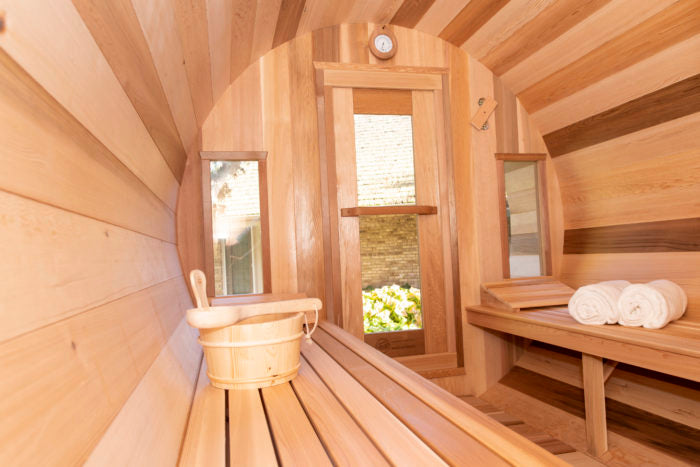Our Traditional Sauna PDFs
Our Traditional Sauna PDFs
Blog Article
Not known Facts About Traditional Sauna
Table of ContentsAn Unbiased View of Traditional SaunaTraditional Sauna Fundamentals ExplainedGetting The Traditional Sauna To WorkLittle Known Questions About Traditional Sauna.The Main Principles Of Traditional Sauna
A lot of the weight shed in a sauna is water loss and is re-gained upon rehydrating. Nevertheless, undeniably sauna can be a vital part of a healthy and balanced weight reduction program. To check out the distinctions in between typical and IR saunas, I will separate these into verifiable, academic, and produced distinctions.Hence, the most popular factor in the saunawhich is at the ceiling directly above the sauna heateris normally between 185 and 190 F. Claims that a typical sauna goes beyond 200 F is simply not true and not suitable for electric saunas sold in the US. The temperature level for a far-infrared sauna is typically established between 120 and 140 F; however, unlike the traditional sauna, the goal in and IR area is not to accomplish a high temperature.
Due to this, the temperature level difference is nearly unnecessary, because excessive sweating results in both sauna types, but the technique of heating up the body is different. In an IR sauna the bather will certainly feel hot and will certainly sweat profusely, but at much reduced temperature levels (Traditional Sauna). Therefore, if the objective is to invest longer periods of time in the sauna, the IR sauna is a great choice
When a standard sauna has actually been appropriately heated, the sauna wall surfaces are cozy, the air temperature level has accomplished set temperature and the rocks are very warmed. As an intriguing side note, the warmed wall surfaces and the rocks are sending out far-infrared warmth, incorporated with the warmed air, to produce an "enveloping heat".
About Traditional Sauna

When the heat is attained, the components cycle on and off to keep the heat. Many standard sauna customers enjoy putting water over the rocks to develop heavy steam to raise sauna humidity levels. The advantages of pouring water over the rocks consist of: making the area a lot more comfy, dampening the nasal flows, and enabling the use of aromatherapy by mixing important oils with the water.

When the power goes into the body, it creates the body temperature level to enhance and ultimately causes perspiration. In an infrared sauna it is very important for the emitters/heaters to continue to be on virtually continuously. Given that there is no mass of rocks to maintain warm, the sauna will cool down if the emitters shut down.
As pointed out above, the sauna bather in an infrared room wishes to place himself in front of running emitters to obtain maximum take advantage of the warmth. The heating time for the 2 areas can be extremely various, relying on just how the areas are made use of. For a typical sauna, a bather needs to enable 30-40 mins for the space to attain a preferred temperature and sites to properly pre-heat the rocks.
The 10-Minute Rule for Traditional Sauna
A well built sauna will usually achieve a temperature level of 150-160 F in about 30-40 mins. For hotter temperatures, the room might require to warmth for a longer duration. Once the room achieves set temperature level, the heating unit will cycle on and off, usually operating regarding 50% of the time. The shielded wall surfaces and the heated rocks will maintain the room warm and at steady temperatures.

Traditional saunas have a tendency to be larger (thus make use of even more electricity) than infrared saunas, although typical saunas are absolutely offered in one and 2 individual sizes. For a two-person typical sauna, 5x6 or 5x7 dimension is most prominent. The leading bench can easily seat two or three people and is additionally long enough to lie down during the sauna session.
The smart Trick of Traditional Sauna That Nobody is Discussing
The average price per kWH of electricity in the U.S. is around $0.11, so a 4.5 kW heating system will certainly cost about $.50 to compete one hour, if the heating system runs constantly for one hour. Generally a sauna heating unit will certainly compete 75% of the very first hour and 50% of succeeding hours on because the aspects cycle once the set temperature is attained.

Ultimately, there is a rarely reviewed distinction in the social experience in between the 2 areas. While our society has shed a few of the social advantage of the typical sauna experience, it can be very socially rewarding (Traditional Sauna). From family time in the sauna, to heart-felt discussions with better halves, to sauna partiesthe standard sauna experience can bring about intimate mingling
Some Of Traditional Sauna
Many higher end infrared areas include tinted light treatment, audio systems and full-glass fronts.
Report this page